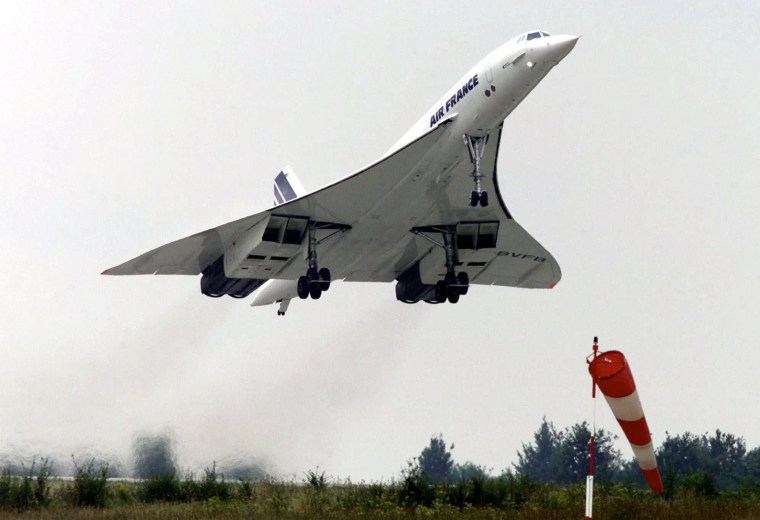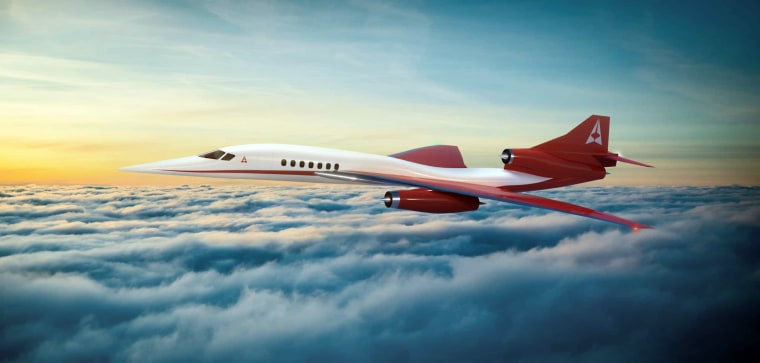The prospects of flying on a supersonic airliner a few hours between New York and London have hit a headwind with the closing of Aerion Supersonic, one of the sector’s leading companies.
Experts say the closure comes amid a downturn in air travel after the pandemic, regulations on supersonic noise and environmental concerns about fuel emissions. And some have also suggested that by the time supersonic airliners take to the skies, travelers could have the option of flying to remote destinations by spaceship, which could cut long-distance travel times to less than an hour.
Bernd Liebhardt, an engineer at the German Aerospace Center in Hamburg who works on civilian supersonic projects, called the closure a major setback.
“A lot of momentum has evaporated," he said. "Aerion was clearly the front-runner and probably years ahead of the competition.”
The Nevada-based company announced last month that it is shutting down operations, although it released new details of its proposed AS3 supersonic airliner in March and unveiled plans for a $375 million manufacturing facility in Florida last year.
Aerion said in a statement that the “hugely challenging” financial environment meant it would not start production of its first supersonic jet, the AS2, which was to pioneer many of the AS3’s technologies.
The closing leaves Denver-based Boom Supersonic as the foremost commercial developer of supersonic passenger aircraft. It rolled-out its XB-1 supersonic demonstrator jet late in 2020, and is due to begin test flights this year.
Boom’s Overture airliner is scheduled to start carrying up to 88 passengers on flights at more than twice the speed of sound in 2029 – cutting the time it takes to fly between New York and London to about three and a half hours. Boom did not respond to a request for comment.
Aerion may have chosen an easier challenge, said Iain Boyd, a professor of aerospace engineering at the University of Colorado Boulder. The AS2 would have flown up to 12 passengers – targeting the well-heeled business jet market – at 1.8 times the speed of sound, or more than 1,300 miles an hour.
But Boom wants to fly at higher speeds – almost 1,700 miles an hour – that might need higher-temperature materials to achieve, and with larger aircraft that increase the danger that some seats cannot be sold, Boyd said – something that contributed to the demise of the supersonic Concorde airliner, which flew until 2003.
Many experts see the drastic downturn in the air travel market caused by the Covid-19 pandemic as a blow for the new supersonic airliners.
The pandemic had a significant impact on major airline companies and aircraft manufacturers, so it was inevitable that it would affect smaller companies like Aerion, said Nicole Viola, a professor of aerospace systems design at the Polytechnic of Turin in Italy and the coordinator of the Stratofly consortium, which researches high-altitude and high-speed aircraft concepts.

The increased fuel use of supersonic passenger jets when airlines are trying to lessen their atmospheric emissions probably also counted against Aerion, Viola wrote in an email – although more efficient propulsion systems and alternative fuels, such as biofuels and synfuels that used atmospheric carbon dioxide, could mitigate that.
A key difficulty is the noise that supersonic passenger jets make – the same problem that contributed to the retirement of the Concorde.
F. Robert van der Linden, a curator at the Smithsonian National Air and Space Museum in Washington, was on the Concorde’s last commercial flight.
He notes that the sonic boom caused when the aircraft reached supersonic speed restricted it to routes over oceans, which limited its commercial viability; but the noise it made during takeoffs and landings was also a major problem: “Great engines, but loud.”
NASA and Lockheed-Martin are developing the experimental X-59 jet that could sharply reduce the noise of sonic booms, and smaller aircraft would make smaller booms, he said. But that might not be enough to please people who live near airports or along airline routes.
“It’s physics – you can't eliminate it,” he said. “If you can reduce it to a point where it doesn't break windows and it doesn't disturb people on the ground, then you could fly supersonically overland. But until that point, no country is going to allow you to do it, and there go half of your routes right there.”
Boyd said he believes it will be more than 10 years before supersonic airliners again become a reality.
And while some parts of the world are eager to reintroduce supersonic airliners, some parts of the world – such as Germany – are not so keen because of their increased noise and pollution, he said.
When and if supersonic passenger flights do return, they may face competition — point-to-point space flights that could carry passengers above the atmosphere, potentially cutting the time of a flight to the other side of the Earth to less than an hour.
Jeffrey Hoffman, a former astronaut and co-director of the Human Systems Laboratory at the Massachusetts of Technology, said point-to-point passenger flights have been proposed by both SpaceX and the space tourism company Virgin Galactic.
“Right now a Virgin flight costs $250,000, which is pretty steep for a trip from New York to Sydney. But with more flights and competition, hopefully prices will come down,” he said in an email.
Van der Linden noted that such rapid flights present a different problem – that the other side of the world could be closed when you arrive.
For example, a morning space flight from New York would land in Japan a bit before midnight, when almost everything was shut down.
“If the whole point is to save time, you didn’t save time because Japan is closed,’ he said. “You’re dealing with the physics of the Earth’s rotation."
